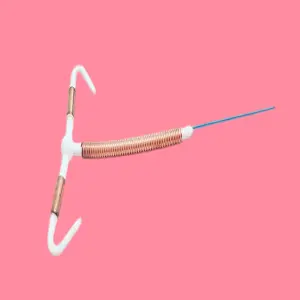The IUD is one of the most popular methods of contraception among women. It is highly effective and long-lasting. However, there are different types of IUDs, each with its own advantages and disadvantages that you should be aware of before choosing one.
What is an IUD?
An IUD is a small device inserted into the uterus to prevent pregnancy. It comes in different types, including copper and hormonal IUDs. Each type has a different mechanism of action and distinct effects.
What are the types of IUDs?
There are two types of IUDs:
1- Copper IUD.

Advantages of the copper IUD:
- It is highly effective in preventing pregnancy for up to 10 years.
- It does not contain hormones, making it suitable for those who do not want hormonal treatment.
- It can be used by women who do not prefer hormonal contraception.
Disadvantages of the copper IUD:
- It may cause heavy bleeding or pain during menstruation.
- Some women experience increased uterine contractions or cramps.
- There is a low risk of infection or the IUD slipping out of place.
2- Hormonal IUD.

Advantages of the hormonal IUD:
- Secrets the hormone progestin, which reduces menstrual bleeding and associated pain.
- Effective for 3-5 years, depending on the type.
- Reduces the risk of ectopic pregnancy.
Disadvantages of the hormonal IUD:
- May cause changes in menstrual cycles or even cessation in some cases.
- Some women experience headaches or mood swings.
- Some women may experience acne or weight gain.
- The Difference Between Copper and Hormonal IUDs
There are several differences between copper and hormonal IUDs, including
Method of Action: The copper IUD prevents pregnancy mechanically and chemically, while the hormonal IUD inhibits ovulation and thickens cervical mucus.
- Effect on the cycle: The copper IUD may increase bleeding and pain, while the hormonal IUD often reduces or stops the cycle.
- Duration of Use: The copper IUD is usually longer than the hormonal IUD.
Tips for Using an IUD
When using an IUD, you should follow the following tips:
- See your doctor before insertion to ensure there are no infections or uterine problems.
- Follow up with regular checkups to ensure the IUD is properly inserted.
- Report immediately any severe pain, unusual bleeding, or unusual discharge.
Which is safer: a hormonal or copper IUD?
Both types are very safe for contraception. The copper IUD is hormone-free but may increase bleeding, while the hormonal IUD reduces bleeding but may cause some side effects.
Is an IUD safe during pregnancy or after childbirth?
The IUD is not inserted during pregnancy, but it can be inserted approximately 6 weeks after vaginal delivery or after a cesarean section, depending on the doctor's advice.
Does the IUD cause pain or heavy bleeding?
Some women may experience pain or light bleeding initially, especially with the copper IUD, but symptoms often improve after a few months.
How is an IUD inserted and removed safely?
Insertion and removal are performed by a specialist doctor using sterile instruments. It is recommended not to attempt to remove an IUD at home to avoid infection or damage.
Summary of the differences between IUD types and the safest ones
Choosing the type of IUD depends on the woman's health condition, her desire to use hormones, and her tolerance for potential side effects.
The copper IUD is excellent for those who want a long-term, hormone-free method, while the hormonal IUD is beneficial for reducing pain and bleeding and improving menstrual comfort.